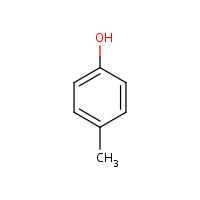p-Cresol
Agent Name
p-Cresol
Alternative Name
4-Methylphenol
CAS Number
106-44-5
Formula
C7-H8-O
Major Category
Other Classes

Synonyms
Para-cresol; 1-Hydroxy-4-methylbenzene; 1-Methyl-4-hydroxybenzene; 4-Cresol; 4-Hydroxytoluene; 4-Methylphenol; Paramethyl phenol; Phenol, 4-methyl-; p-Cresylic acid; p-Hydroxytoluene; p-Kresol [German]; p-Methylhydroxybenzene; p-Methylphenol; p-Oxytoluene; p-Toluol; p-Tolyl alcohol; para-Cresol; para-Cresylic acid; Phenol, 4-methyl-; Cresol, p-; Cresol, p-isomer; Cresol, para-; [ChemIDplus] p-Methylphenylol; Paracresol; [HSDB] UN2076; UN3455
Category
Phenols
Description
Solid with a phenolic odor; mp = 35.5 deg C; [Merck Index] Colorless solid that darkens on exposure to light and air; [ICSC] Colorless, white, or pink solid; [NTP] Colorless crystals; [Sigma-Aldrich MSDS]
Sources/Uses
Used as an industrial solvent, to make synthetic resins, and in disinfectants and fungicides; [Merck Index] Used to make explosives, fragrances, antioxidants, lubricating oils, motor oils, rubbers, polymers, elastomers, and other chemicals; Also used as a metal cleaning agent, solvent for wire enamels, ore flotation agent, coal desulfurizing agent, flavoring agent, and in the petroleum, photographic, paint, dye, and agricultural industries; [HSDB] Used in degreasing compounds, paintbrush cleaners, engine cleaners, and in the textile industry; [NTP] Naturally occurring in many plants, human urine, petroleum, and coal tar, as well as emissions from the combustion of wastes, coal, wood, vehicles, and cigarettes; Used primarily as an intermediate for BHT (antioxidant), other antioxidants, anisaldehyde, and other intermediates; Uses for all cresol isomers include as preservatives or stabilizers in cleaning/washing agents, surface treatment products, paints, adhesives, binding agents, corrosion inhibitors, and impregnation materials; [OECD SIDS: m-/p-Cresol Category - 2003]
Comments
Causes burns; Inhalation may cause pulmonary edema; Short-term exposure may have effects on the CNS (lowering of consciousness) and blood (destruction of blood cells); Prolonged or repeated exposure may have effects on the nervous system (impaired functions) and blood (anemia); Can be absorbed through skin; [ICSC] May cause second degree skin burns after a few minutes contact; [CHRIS] The most toxic of the three cresol isomers; May cause skin sensitization; [HSDB] No evidence of skin sensitization in limited studies of humans and guinea pigs using p-cresol and m-/p-cresol; A survey reports hypersensitivity reactions of certain individuals to cresol (unspecified isomer); Neither isomer produced mortality or clinical signs of toxicity following exposure to saturated vapor concentrations, although inhalation of aerosols may be fatal; [OECD SIDS: m-/p-Cresol Category - 2003] Safe when used as a flavoring agent in food; [JECFA] Causes burns; Inhalation may cause corrosive injuries to upper respiratory tract and lungs; Highly toxic by inhalation; Toxic by ingestion and skin absorption; Targets the CNS, lungs, liver, kidney, and eyes; [Sigma-Aldrich MSDS] See "Cresol, all isomers."
Reference Link #1
Biomedical References
Exposure Assessment
Skin Designation (ACGIH)
Yes
TLV (ACGIH)
20 mg/m3, inhalable fraction and vapor
PEL (OSHA)
22 mg/m3
Vapor Pressure
0.11 mm Hg
Odor Threshold Low
0.00046 ppm
Odor Threshold High
0.2 ppm
Lethal Concentration
LC50 (rat) > 710 mg/m3/1hr
Explanatory Notes
Odor threshold low (detection) and high (recognition) from CHRIS; The Guide in the Emergency Response Guidebook is for "Cresols."
NFPA
high ambient temp required
Adverse Effects
Anemia
Hemolytic anemia
Toxic Pneumonitis
Yes
Methemoglobinemia
MetHgb is secondary toxic effect
Hepatotoxin
Hepatoxic (a) from occupational exposure (secondary effect) or (b) in animal studies or in humans after ingestion
Dermatotoxin
Skin burns
ACGIH Carcinogen
Not Classifiable
Diseases, Processes, and Activities Linked to This Agent
Processes